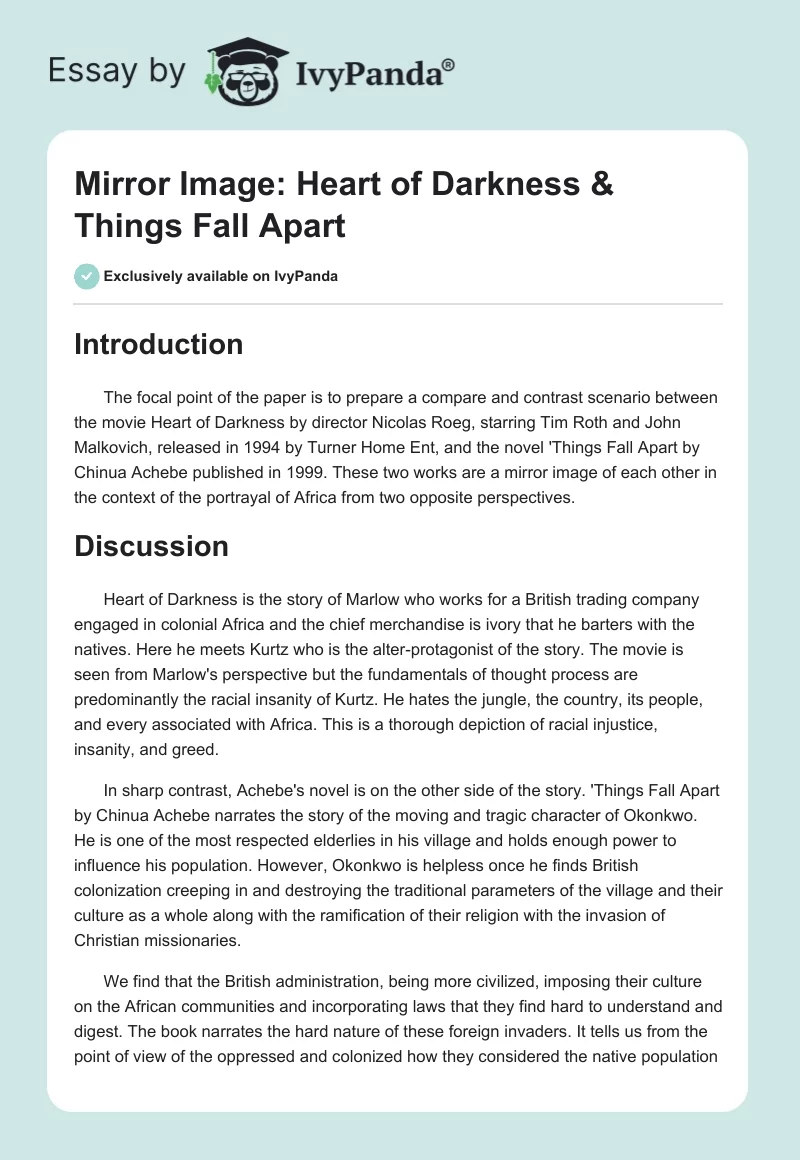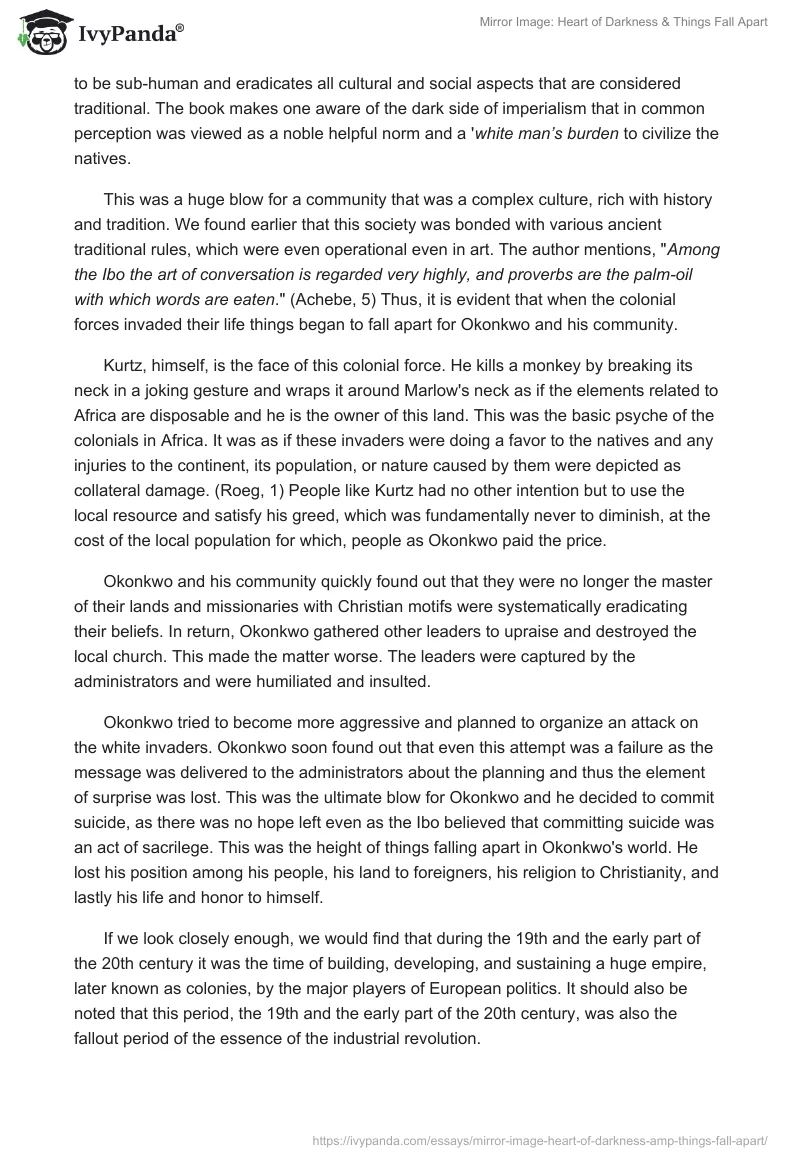Introduction
The focal point of the paper is to prepare a compare and contrast scenario between the movie Heart of Darkness by director Nicolas Roeg, starring Tim Roth and John Malkovich, released in 1994 by Turner Home Ent, and the novel ‘Things Fall Apart by Chinua Achebe published in 1999. These two works are a mirror image of each other in the context of the portrayal of Africa from two opposite perspectives.
Discussion
Heart of Darkness is the story of Marlow who works for a British trading company engaged in colonial Africa and the chief merchandise is ivory that he barters with the natives. Here he meets Kurtz who is the alter-protagonist of the story. The movie is seen from Marlow’s perspective but the fundamentals of thought process are predominantly the racial insanity of Kurtz. He hates the jungle, the country, its people, and every associated with Africa. This is a thorough depiction of racial injustice, insanity, and greed.
In sharp contrast, Achebe’s novel is on the other side of the story. ‘Things Fall Apart by Chinua Achebe narrates the story of the moving and tragic character of Okonkwo. He is one of the most respected elderlies in his village and holds enough power to influence his population. However, Okonkwo is helpless once he finds British colonization creeping in and destroying the traditional parameters of the village and their culture as a whole along with the ramification of their religion with the invasion of Christian missionaries.
We find that the British administration, being more civilized, imposing their culture on the African communities and incorporating laws that they find hard to understand and digest. The book narrates the hard nature of these foreign invaders. It tells us from the point of view of the oppressed and colonized how they considered the native population to be sub-human and eradicates all cultural and social aspects that are considered traditional. The book makes one aware of the dark side of imperialism that in common perception was viewed as a noble helpful norm and a ‘white man’s burden to civilize the natives.
This was a huge blow for a community that was a complex culture, rich with history and tradition. We found earlier that this society was bonded with various ancient traditional rules, which were even operational even in art. The author mentions, “Among the Ibo the art of conversation is regarded very highly, and proverbs are the palm-oil with which words are eaten.” (Achebe, 5) Thus, it is evident that when the colonial forces invaded their life things began to fall apart for Okonkwo and his community.
Kurtz, himself, is the face of this colonial force. He kills a monkey by breaking its neck in a joking gesture and wraps it around Marlow’s neck as if the elements related to Africa are disposable and he is the owner of this land. This was the basic psyche of the colonials in Africa. It was as if these invaders were doing a favor to the natives and any injuries to the continent, its population, or nature caused by them were depicted as collateral damage. (Roeg, 1) People like Kurtz had no other intention but to use the local resource and satisfy his greed, which was fundamentally never to diminish, at the cost of the local population for which, people as Okonkwo paid the price.
Okonkwo and his community quickly found out that they were no longer the master of their lands and missionaries with Christian motifs were systematically eradicating their beliefs. In return, Okonkwo gathered other leaders to upraise and destroyed the local church. This made the matter worse. The leaders were captured by the administrators and were humiliated and insulted.
Okonkwo tried to become more aggressive and planned to organize an attack on the white invaders. Okonkwo soon found out that even this attempt was a failure as the message was delivered to the administrators about the planning and thus the element of surprise was lost. This was the ultimate blow for Okonkwo and he decided to commit suicide, as there was no hope left even as the Ibo believed that committing suicide was an act of sacrilege. This was the height of things falling apart in Okonkwo’s world. He lost his position among his people, his land to foreigners, his religion to Christianity, and lastly his life and honor to himself.
If we look closely enough, we would find that during the 19th and the early part of the 20th century it was the time of building, developing, and sustaining a huge empire, later known as colonies, by the major players of European politics. It should also be noted that this period, the 19th and the early part of the 20th century, was also the fallout period of the essence of the industrial revolution.
The industrial revolution freed the entrepreneurs from the usual bondage of the traditional economy and for the general, it was the time for new social bondage free from the earlier pseudo- feudal economic system. In this context and social structure, it would have been very hard to digest the ideals of imperial expansions through the method of brutal strength but the authorities made the western world believe that whatever action was taken in the colonies was an good measure for the natives.
Conclusion
It is logical to feel sympathetic to Okonkwo just as it is logical to be dismayed and angry at the deeds of Kurtz.. his community was indeed uncivilized, in a western context, but it was his own culture, his religion. No matter how much superstition was present in Okonkwo’s society, it was his society and the imperialists had no right to impose their laws and rules on the natives. Both the works narrates this incident but from two opposing directions. One is the point of view of the oppressed and the other is that of the oppressor. This makes the paper a very interesting text as it presents a formulation of, in a way, cause and effect narratives.
References
- Roeg, Nicolas; Heart of Darkness; Turner Home Ent; 1994
- Achebe, C; Things Fall Apart; Wellington: Allied Publications; 1999


